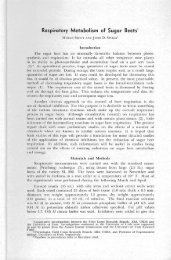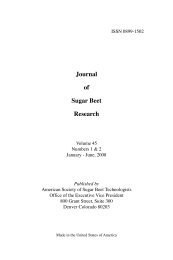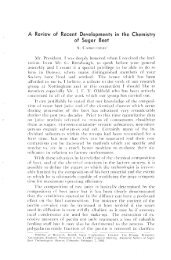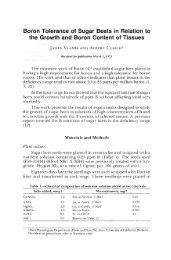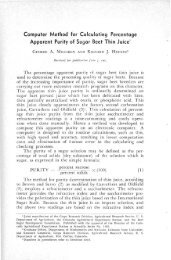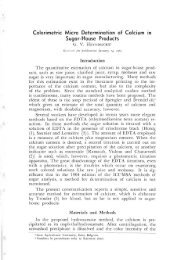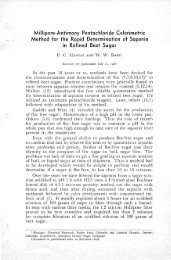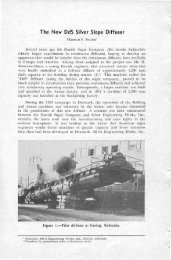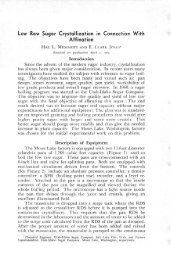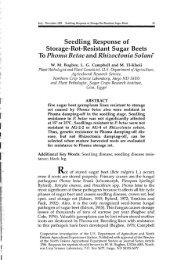Mathematical Approach to Determine Vacuum Pan Boiling ... - Vol
Mathematical Approach to Determine Vacuum Pan Boiling ... - Vol
Mathematical Approach to Determine Vacuum Pan Boiling ... - Vol
Create successful ePaper yourself
Turn your PDF publications into a flip-book with our unique Google optimized e-Paper software.
<strong>Mathematical</strong> <strong>Approach</strong> <strong>to</strong> <strong>Determine</strong> <strong>Vacuum</strong> <strong>Pan</strong><br />
<strong>Boiling</strong> Time for Full Seeding Method<br />
Using Milled Fondant<br />
ALLISON S. CHANG!<br />
Received for publication February 19, 1964<br />
Sucrose crystallization rate is a controlling fac<strong>to</strong>r in sugar end<br />
operation. There are several methods available at the present<br />
time for determining sucrose crystallization rate in the labora<strong>to</strong>ry.<br />
In fact many methods, proved <strong>to</strong> be satisfac<strong>to</strong>ry in the labora<strong>to</strong>ry,<br />
have failed <strong>to</strong> be applicable in actual full-scale operation. This<br />
is particularly true in pan boiling.<br />
The purpose of this investigation was <strong>to</strong> develop a suitable<br />
equation for use at the fac<strong>to</strong>ry level for determination of pan<br />
boiling time.<br />
Equipment<br />
The following equipment was used 111 this investigation:<br />
(1). White calandria pan.<br />
3,340 sq.ft. heating surface, Z%" OD, 1677 bi-metal tubes,<br />
0.065" steel outside, 0.042" coooer inside. 3'- % " long,<br />
437 eu .ft. graining volume. 1750 eu.ft. strike volume,<br />
15', 0" OD pan diameter. 13'-6" OD calandria diameter,<br />
75 hp circula<strong>to</strong>r at 75 RPM, steam at 10 PSIG.<br />
(2). <strong>Pan</strong> au<strong>to</strong>matic controls.<br />
<strong>Pan</strong> instruments were supplied by Taylor Instrument<br />
Company.<br />
The au<strong>to</strong>matic controls consisted of the following items:<br />
(a) Consistency probe and controller.<br />
(b) Level controller and transmitter.<br />
(c) Temperature controller and transmitter.<br />
(d) Absolute pressure controller.<br />
(3). George Lory design, Lasico erystalscope (pan microscooe)<br />
was inserted in<strong>to</strong> the pan just below the normal graining<br />
level. Crvstalscope micrometer has a scale which is 5 units<br />
lOn!!. Eaeh unit is divided in<strong>to</strong> 20 subdivisions. Each subdivision<br />
is equivalent <strong>to</strong> 0.001 inches. Total length of s(,ale<br />
is 0.1 inches.<br />
(4). Polaroid camera.<br />
(5). Complete ball mill <strong>to</strong> make the fondant.<br />
1 Chemical Engineer, Engineering Department, The Amalgamated Sugar Compan'""<br />
Ogden, Utah.
VOL. 13, No. 3, OCTOllER 1964 20:1<br />
From theoretical and actual standpoint, it is desirable <strong>to</strong> boil<br />
the pan at higher super-saturation. However, super-saturation<br />
above 1.S should be avoided for full seeding method, because<br />
super-saturation above I.S is in the Labile zone which will cause<br />
the formation of fine grain and unwanted grain size.<br />
There is an optimum condition at which fine grain will not<br />
form and the boiling time is minimum. This condition exists<br />
at super-saturation of I.S which is the upper limit of Metastable<br />
zone. In this zone, the crystal will grow but practically no new<br />
crystal will form.<br />
Equation (4) is <strong>to</strong> be used <strong>to</strong> estimate the final green purity<br />
or mother liquor purity P for boiling the pan from initial purity<br />
p o and constant super-saturation S for <strong>to</strong>tal boiling time t.<br />
Equation (S) is <strong>to</strong> be used <strong>to</strong> estimate the boiling time for<br />
boiling the pan from initial purity p o <strong>to</strong> final green purity P<br />
at constant super-saturation S.<br />
It is rather difficult <strong>to</strong> boil the pan at constant super-saturation<br />
without proper and reliable instrumentations. Fortunately,<br />
Taylor Instrument Company has developed a temperature mcasuring-<br />
device which is quite unique in pan instrumentations.<br />
The temperature measuring element is called Transaire Temperature<br />
Capillary Bulb which was inserted in the vapor line<br />
between pan and condenser. This temperature sensing bulb is<br />
quite sensitive, measuring any small change in the temperature<br />
of super-heated vapor leaving the surface. This temperature<br />
change is amplified and recorded on a recorder calibrated for<br />
20° C span over full chart. With this temperature-measuring<br />
instrument and proper recording chart shown on Figure 1 <strong>to</strong>gether<br />
with accurate constant super-saturation curves for fiIImass<br />
as shown on Figures 2, 3 and 4 for 6" Hg abs., 7" Hg abs. and<br />
8" Hg abs. respectively, it is possible <strong>to</strong> boil the pan at constal1l<br />
super-saturation.<br />
Figure 1.
206 JOURNAL OF THE A. S. S. B. T .<br />
began <strong>to</strong> brix up. At this time the fillmass temperature started<br />
<strong>to</strong> rise above the set point, the steam flow was throttled again<br />
<strong>to</strong> avoid excess temperature rise and <strong>to</strong> hold the super-saturation<br />
constant at 1. 35 until the pan was dropped.<br />
Estimation of Constant K<br />
Knowing the purities of standard liquor and high green, the<br />
boiling time from graining <strong>to</strong> finishing the strike and the constant<br />
super-saturation at which the pan is being boiled, the<br />
constant k can be calculated from Equation (3).<br />
In po - In P = - k ( S - 1 ) t<br />
1n p o -- In P<br />
Solve for k, k = (S .- I ) t ..... (6)<br />
For the experimental boiling shown on Figure I:<br />
initial standard liquor purity 94.0<br />
final high green purity 86.2<br />
su per-saturation 1.35<br />
boiling time 120 minutes<br />
absolute pressure 7" Hg abs.<br />
k can be estimated from Equation (6).<br />
k = In 94.0 - In 86.2 = 0.08662 = 0.08662 = 000')06')<br />
(1:35 - 1) 120 0. 35 (120) 42 . - <br />
During the boiling time of 120 minutes, temperature of fillmass<br />
was controlled so that super-saturation of fillmass not <strong>to</strong><br />
exceed or drop below 1.35. This was very difhcult <strong>to</strong> accomplish<br />
because the location of 1.35 super-saturation was not clearly<br />
known from the recording chart shown on Figure 1. Therefore,<br />
after the strike was completed, the temperature chart was examined<br />
for intermediate points <strong>to</strong> determine if the entire boiling<br />
was conducted at constant super-saturation of 1.35. This<br />
was done by computing the intermediate mother liquor purity<br />
Pi using the k value obtained above, time t after graining and<br />
constant super-saturation of 1. 35. Pi was located on Figure 3 at<br />
1.35 super-saturation and the corresponding fillmass temperature<br />
was read. The resulting fillmass temperature was the same as<br />
the temperature recorded on Figure 1. Hence, the pan was<br />
boiling at constant super-saturation of 1.35.<br />
For the experimental boiling:<br />
k = 0.002062, P" = 94.0, t = 30 minutes alter graining,<br />
super-saturation == 1.35.<br />
Substituting the above data in<strong>to</strong> Equation (4):<br />
In PI In 94 - 0.002062 (1.35 - I ) 30<br />
6.84588 - 0.002062 (0.3F» 30<br />
6.84588 - 0.02165 = 6.8242:l<br />
Hence, PI = 91.9 purity.
210 JOURNAL OF THE A. S. S. B. T.<br />
""I[ ...,HUTl1<br />
Figure ll.-Mean crystal dimension vs. boiling time.<br />
.. ' .f<br />
, • • _ M _ _ M _ _ _ _ _ _ _<br />
1"1"[, .. ,NUf[:!'<br />
Figure 12.-LN P vs. time based on equation 7.<br />
Final high green purity can be estimated by knowing the<br />
amount of milled fondant used and the screen analysis of sugar<br />
produced. For the experimental boiling, 200 c.c. of milled<br />
fondant was used <strong>to</strong> gTain the pan and 0.016 MA sugar was<br />
obtained.<br />
<strong>Vol</strong>ume of 0.016 MA crystal = 0.7 as = 0.7(1.6 X 10-2)S =<br />
2.87 X 10- 6 ina/crystal<br />
Number of crystal in 200 c.c. milled fondant = 200 X 2.5 X<br />
Ion crystals<br />
Total crystal volume = 5 X 1011 X 2.87 X 10- 6 = 1,435,000<br />
in 3 = 830.44 cu.ft.<br />
Density of sugar = 99.15#/ cu.ft.<br />
Weight of crystallized sugar = 830.44 X 99.15 = 82 ,3 38 lb.<br />
Strike volume = 1750 cu.Et. @ 91.4 RDS, 94.04#/ cu.ft., 94.0<br />
purity
VOL. 13, No.3, OCTOBER 1964<br />
Refrac<strong>to</strong>meter Dry Substance = 1750 X 94.04 X 0.914 =<br />
150,417 lb.<br />
Sugar in fillmass = 150,417 X 0.94 = 141,392 lb.<br />
H' I . 141 ,392 - 82,338 8'<br />
Ig1 green punty = 150,417 _ 82,338 X 100 = 6.7<br />
Crysta II " 82,338 00 59 2<br />
lZatIOn = 141 ,392 X I = . %<br />
High green purity calculated above checked well with the actual<br />
value of 86.2 which was determined in the labora<strong>to</strong>ry. Sucrose<br />
crystallization calculated above also checked with GO IJo crystallization<br />
obtained in the labora<strong>to</strong>ry.<br />
Amount of milled fondant required <strong>to</strong> obtain specified MA<br />
and high green purity was shown on the following example:<br />
211<br />
Basis: 1000 cu.ft. of fillmass @ 94.0 purity, 91.4 RDS,<br />
94.04#I cu.ft. <strong>to</strong> obtain 0.017 MA sug-ar and 86.0 high<br />
green purity. The pan <strong>to</strong> be boiled at constant 1.4<br />
su per-sa turation.<br />
From Equation (7),<br />
In po - In P In 94-- In 86<br />
t = 0.002062 (S-I) 0.002062 (1.4-1)<br />
= 108 minutes 1 hour 48 minutes<br />
RDS in fi.llmass = 1000 X 94.04 X .914 = 85,953 lb.<br />
Sugar in fillmass = 85,953 X 0.94 = 80,795 lb.<br />
Let x = lb. of sugar <strong>to</strong> be crystallized<br />
80,795 - x<br />
86.0 = 85,953 _ x (100)<br />
Solve for x, x = 49,107 lb. of sugar <strong>to</strong> be crystallized.<br />
Density of sugar = 99.15#/cu.ft.<br />
. 49,107<br />
<strong>Vol</strong>ume of sugar <strong>to</strong> be crystallized = 99.15 = 495.28 cu.ft. =<br />
855,844 cu .in.<br />
<strong>Vol</strong>ume of 0.017 MA sugar = 0.7 a" = 0.7 (1.7 X 10- 2 )3 = 3.439<br />
X 10- 6 cu. in. per crystal<br />
1<br />
Number of crystal per cu .in. = :1.439 X 10- 6 = 290,782<br />
Total number of crystal in fillmass <strong>to</strong> be crystallized = 855,844 X<br />
290,782 = 2,489 X 1011<br />
Milled fondant contains 2.5 X lO D crystals per c.c.
212 JOURNAL OF THE A. S. S. B. T.<br />
. . 2.489 X lOll<br />
Amount of milled fondant required = 2.5 X 10" = 99.6 c.c.<br />
Therefore, 99.6 c.c. of milled fondant for 1000 Frs strike is required<br />
<strong>to</strong> seed the pan in order <strong>to</strong> obtain 0.017 MA sugar and<br />
86.0 high green purity for <strong>to</strong>tal boil ing time of I hour 48 minutes<br />
at 1.4 constant super-saturation.<br />
Summary<br />
<strong>Vacuum</strong> pan boiling time can be accurately estimated by<br />
proper application of au<strong>to</strong>matic controls and Equat·ion (7) provided<br />
that the boiling- is <strong>to</strong> be conducted at constant supersaturation<br />
and constant pressure.<br />
For the given initial standard liquor and final green puntIes,<br />
boiling time can be greatly reduced by boiling the pan at higher<br />
super-saturation provided that the super-saturation does not exceed<br />
1.5 which is the upper limit of Metastable zone. If the pan<br />
is <strong>to</strong> be boiled above 1.5 super-saturation, much of the fine grain<br />
formed during boilin£\' will be so fine that they will not be retained<br />
on the centrifugal screen. They merely go through the<br />
screen and are remelted in the high green syrup. Thus, the high<br />
green purity for the pan boiling above 1.5 super-saturation will<br />
not be the same as the purity estimated by Equation (7). Equation<br />
(7) is applicable <strong>to</strong> the conditions where the sugar from<br />
the mother liquor is deposited on the existing sugar crystals and<br />
is retained on the centrifugal screen.<br />
High green purity also can be estimated by using' Equation<br />
(7), if initial thick juice purity, boiling time and constant supersaturation<br />
at which the pan is <strong>to</strong> be boiled are known.<br />
Constant k may vary from fac<strong>to</strong>ry <strong>to</strong> fac<strong>to</strong>ry due <strong>to</strong> difJerent<br />
constituents in the non-sug'ar and different steam pressure at<br />
calandria section of pan. Therefore, constant k is <strong>to</strong> be determined<br />
for each fac<strong>to</strong>ry.<br />
P<br />
po<br />
S<br />
k<br />
a<br />
N omenclature<br />
Purity of mother liquor<br />
Initial standard liquor purity<br />
Super-saturation<br />
Constant <strong>to</strong> be determined from Equation<br />
<strong>Boiling</strong> time<br />
Mean dimension of sugar crystal<br />
(6)
VOL. 13, No.3, OCTOBER 1964<br />
Acknowledgment<br />
213<br />
Cooperation from Engineering Department, Research Department<br />
and Operating Department made this work possible. Mr.<br />
.J. G. Ziegler, Taylor Instrument Company, and Mr. .Julian<br />
Johnson, Manager of Research Labora<strong>to</strong>ry, The Amalgamated<br />
Sugar Company have contributed <strong>to</strong> this investigation.<br />
Literature Cited<br />
GILLETT, EUGENE C. 1948. Low grade sugar crystallization. California and<br />
Hawaiian Sugar Refining Corp., ltd., Crockett, Cal.ifornia.<br />
HONIG, PIETER. 1959. Principle of Sugar Technology. <strong>Vol</strong>. II, Elsevier Pub·<br />
lishing Company, New York.<br />
MCGINNIS, R. A. 1951. Beet-Sugar Technology. R einhold Publishing Corp.,<br />
New York.<br />
ZIEGLER, J. G. 1963. Experiments in vacuum pan control. J. Am. Soc. Sligar<br />
Beet Techno!. 12 (6): 462·467.



